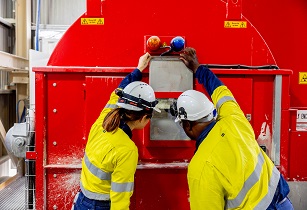QMAG Pty Limited, which owns the Kunwarara deposit of cryptocrystalline magnesite in Central Queensland, Australia, has incorporated a new TOMRA solution in order to reduce heavy media usage and extend the life of the deposit
QMAG, part of the Refratechnik Group, mines the ore at its Australian site using an open-pit method and processes it into high-quality fused (FM), dead burnt (DMB) and caustic calcined (CCM) magnesia products at the Pankhurst facility nearby. Having used its first Ultrasort laser machine in 1994 (with a second following a few years later), the company is the longest continuous user of sensor-based ore sorting in Australia. Once ore was fed through a Dense Media Separation (DMS) system, the Ultrasort sorters removed the sandstone, gravel and dark coloured dolomite from the product. However, after 22 years in operation, the sorters were becoming antiquated and could no longer be supported.
With a new solution required, TOMRA X-Ray Transmission technology was put forward with a TOMRA XRT sorter installed as a stand-alone plant on site in 2016.
“It was a success story: we could now process very high calcium content material that we couldn’t do as effectively with the DMS or laser sorting equipment. This gave the ability to produce much lower calcium content magnesite grades suitable for our customers,” adds Alex Padya, process engineer at QMAG.
In 2018, the XRT machine was moved into the sorting plant, where it replaced the remaining Ultrasort that had reached the end of its life, and the DMS drum was decommissioned.
“With this decision, we halved our heavy media usage in that part of the circuit and went to a standalone XRT circuit,” remarked Josh Dawson, production superintendent at the QMAG mine.
As a result, the XRT circuit has delivered significant savings in energy and water usage, increased the plant’s efficiency, as is easy to use – ultimately exceeding the expectations of QMAG.
Dawson explained, “When we originally made the business case, we thought that it would be used to upgrade the lower quality magnesite ores to produce grades suitable for agricultural purposes, while the heavy media cyclones would make our lower silica materials for other applications. However, by collaborating with TOMRA to optimise the performance of the XRT unit, we can now turn agricultural products into much higher grades required by the Parkhurst processing plant.”
With the solution performing the way it was, QMAG updated its plant by replacing the six-year-old unit with a new TOMRA XRT sorter. In addition, a second unit has been added to further increase production capacity through this process route. QMAG is currently considering the possibilities that ores sorting technology can open up for the future.
Dawson concluded, “We are looking as a business for our next stages, potentially moving away from the traditional heavy media, and I see a future of a lot more ore sorting technology at QMAG. The technology is moving fast and TOMRA is a leader in this technology. We are excited to see what technology TOMRA develops next.”





















